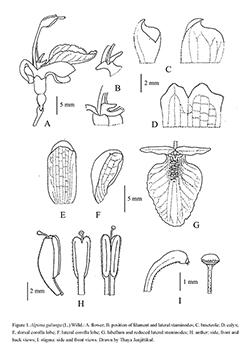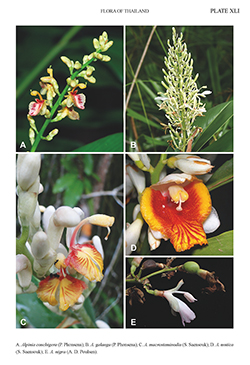e-Flora of Thailand
Volume 16 > Part 2 > Year 2023 > Page 340 > Zingiberaceae > Alpinia
3. Alpinia galanga (L.) Willd.wfo-0000338490
Sp. Pl. 1(1): 12. 1797; Gagnep., Fl. Indo-Chine 6(1): 87. 1908; Wu & Larsen in C.Y.Wu & P.H.Raven (eds), Fl. China 24: 343. 2000.— Maranta galanga L., Sp. Pl., ed. 2, 1: 3. 1762.— Amomum galanga (L.) Lour., Fl. Cochinch.: 5. 1790. Fig. 1, Plate XLI: B.
Accepted Name : This is currently accepted.
Synonyms & Citations :
Description : Herb 1.5–2 m tall. Leaf sheath pubescent near base of petiole and ligule; ligule ovate, 5–7 by 5 mm, apex rounded, pubescent; blade lanceolate-oblong, 25–50 by 6–10 cm, glabrous except pubescent at base of midrib and margin below or both surfaces pubescent, base attenuate, apex acute-acuminate, ca 1 cm long; petiole 5–7 mm long, pubescent. Inflorescence paniculate, erect, 20–30 cm long, usually with 1–2 large branches; subtended by 2 or 3 long sheaths when young, each sheath 15–20 by 2–3 cm and shortly pubescent; peduncle 5–10 cm long, pubescent or glabrous; rachis 20–25 cm long, pale green, glabrous or pubescent, bearing numerous cincinni; bracts oblong, ca 1.2 by 0.2 cm, apex acute-acuminate, very variable, apparently soon caducous, on lower branches shorter or lacking, white-greenish, glabrous or shortly pubescent; peduncle of cincinnus 1–1.5 cm long, glabrous or shortly pubescent with 3–5 flowers per cincinnus; bracteoles oblong-ovate, 1–1.2 by 0.7–0.8 cm, apex acute, enclosing bud only when young, white to greenish, glabrous or shortly pubescent; pedicel 5–7 mm long, pale green, glabrous or shortly pubescent. Flowers white or greenish; ovary ovoid, shortly pubescent; style slender; stigma cup-shaped, ciliate; epigynous glands ca 2 mm long; calyx tubular, 1–1.2 by 0.5 cm, apex trilobed, lobes acute, shortly pubescent or glabrous, white or greenish; floral tube as long as calyx, 1–1.2 by 0.4 cm, greenish, dorsal corolla lobe oblong, 1.5–2 by 0.6–0.8 cm, apex hooded, greenish and white at tip, shortly pubescent and glabrous, lateral corolla lobes narrowly oblong, ca 1.2 by 0.5 cm, apex hooded, greenish and white at apex, shortly pubescent or glabrous; lateral staminodes purple or reddish at base of labellum, subulate or linear and terete, ca 1 cm long, apex acute; labellum white with red veins and short, oblique, pink lines at each side of midrib, obovate-spathulate, 2–2.5 by 0.7–1 cm, apex bilobed by 1–1.3 cm, margin irregularly crinkled, shortly pubescent dorsally, densely papillose at base; stamen: filament 1–1.5 by 0.1–0.2 cm, shortly pubescent or glabrous; anther 7–9 by 3–4 mm, yellow, densely papillose, anther crest wanting. Fruit a globose capsule, green when young, red when mature, glabrous; seeds angled, aril white.
Thailand : Unknown locality (type of Alpinia zingiberina); NORTHERN: Chiang Mai, Lampang, Phitsanulok; NORTH-EASTERN: Phetchabun, Loei; EASTERN: Ubon Ratchathani; SOUTH-WESTERN: Kanchanaburi; SOUTH-EASTERN: Chanthaburi; PENINSULAR: Surat Thani, Phangnga, Songkhla, Yala.
Distribution : India, Bangladesh, Myanmar, China, Cambodia, Laos, Malaysia (type of Heritiera alba), Indonesia (unknown locality – lectotype of Maranta galanga, Java – type of Alpinia pyramidata), Vietnam, Singapore, the Philippines.
Ecology : In open areas in dry evergreen and mixed deciduous forests, 50–1,250 m alt., also cultivated throughout Thailand. Flowering: April–September; fruiting: July–October.
Vernacular : Kha (ข่า), katuk karohini (กฏุกกโรหินี); kha yai (ข่าใหญ่), kha yuak (ข่าหยวก), kha luang (ข่าหลวง)(Northern); se-oe khoei (เสะเออเคย), sa-e choei (สะเอเชย)(Karen-Mae Hong Son).
Notes: Alpinia galanga is similar to A. scabra but differs in having red mature fruits and larger bracts.


